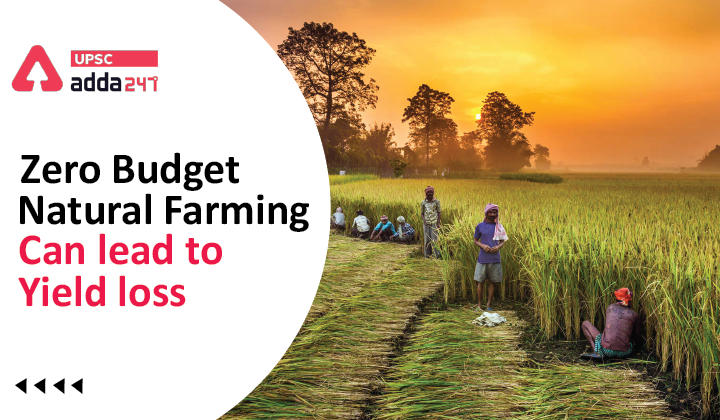Table of Contents
Zero Budget Natural Farming: Relevance
- GS 3: Major crops-cropping patterns in various parts of the country, – different types of irrigation and irrigation systems storage, transport and marketing of agricultural produce and issues and related constraints
Zero Budget Natural Farming: Context
- Recently, an expert committee set up by Indian Council of Agricultural Research (ICAR) stated that large scale adoption of Zero Budget Natural Farming (ZBNF) would result in ‘tremendous reduction’ in production of agricultural crops.
Zero Budget Natural Farming: Key points
- ICAR had set up the committee in 2019 to empirically validate the results of ZBNF, which was promoted by two consecutive budgets—2019-20 and 2020-21.
- In the both the budgets, the Finance Minister referred ZBNF as an ‘innovative model for doubling farmers’ income’.
What is ZBNF?
- Zero budget natural farming is a type of farming that promotes chemical-free agricultural practices.
- ZBNF was originally introduced by agriculturist Subhash Palekar in the mid-1990s as an alternative to the Green Revolution methods.
- FAO explains that ‘zero budget’ farming promises to end a reliance on loans and drastically cut production costs, ending the debt cycle for desperate farmers.
- The word ‘budget’ refers to credit and expenses, thus the phrase ‘Zero Budget’ means without using any credit, and without spending any money on purchased inputs.
- ‘Natural farming’ means farming with Nature and without chemicals.
Expert committee on ZBNF
- The committee stated that there would be tremendous yield loss if ZBNF is adopted on a large scale which may compromise India’s food security.
- The committee has stressed on:
- Conducting long term field trials.
- Carrying out future research on ZBNF only in rainfed regions instead of irrigated zones which produce the biggest chunk of agricultural crops production in the country.
Impact of green revolution
- Positive impact: Introduction of high yielding seeds, application of chemical fertiliser and assured irrigation, India has emerged as one of the biggest producers of several agricultural crops such as rice, wheat, pulses and oilseeds.
- Negative impact: Though the yield has increased, there has been gradual degradation of soil health because of excessive use of chemical fertiliser and pesticides in the last four decades.
Recommendation of committee
- In place of ZBNF, the expert committee has recommended adoption of an integrated production system through usage of farm practices such as conservation agriculture through usage of farmyard manure, inter-cropping, crop diversification and integrated nutrient management for improving soil health.
ZBNF in India: Present status
- Many of the elements of ZBNF such as name of Beejamrit (seed-microbial coating), Jeewamrit (soil-microbial enhancer), Waaphasa (soil-aeration), and Acchadana (Mulching), etc, are currently practised under the conservation agriculture.
- Also, Bhartiya Prakritik Krishi Padhati (BPKP), a sub scheme of Paramparagat Krishi Vikas Yojana (PKVY), is being implemented since 2020-21, which focuses on promoting traditional indigenous practices including ZBNF.
Also Read:





 TSPSC Group 1 Question Paper 2024, Downl...
TSPSC Group 1 Question Paper 2024, Downl...
 TSPSC Group 1 Answer key 2024 Out, Downl...
TSPSC Group 1 Answer key 2024 Out, Downl...
 UPSC Prelims 2024 Question Paper, Downlo...
UPSC Prelims 2024 Question Paper, Downlo...




